When it comes to creating social media content, the amount of knowledge and choices can seem a bit overwhelming. How often should you post? What kind of posts should you create? How do you schedule out media content in advance? Which social media platforms should you post on? The questions are endless.
Happily, our social media experts love sharing their knowledge on social media marketing, so we compiled their tips and best practices all about social media content. If you’re unsure of how your company can create engaging, optimized social media content, read on!
What Should You Post on Social Media?
One of the most common questions we hear about social media marketing is, “What should I post?” While that may seem like an easy question to answer, it’s actually quite broad and complex. Each social media platform has different media content capabilities and strategies – for instance, the blog link you post on Facebook isn’t going to get much (if any) traction if you post it on Instagram.
Every piece of content you post should consider your overall strategy, goals, and target audience. While there are a million variations of social media content out there, they fall into a few basic types of content:
Types of Social Media Content
- Curated Content: Curated social media content is posts, articles, or other media that you share (or curate) from other sources. This is a great way to boost engagement and interaction on social media platforms, and it saves your team time by not having to create original content with every post.

- Interactive Content: Quizzes, surveys, webinars, 360 Videos…all of these are examples of interactive content. This type of social media content pulls people into your business, has extremely high engagement, and can help spread your brand’s awareness.
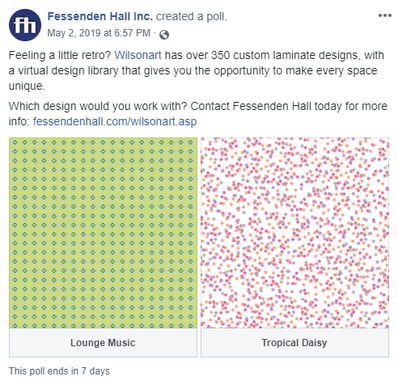
- User-Generated Content: Nothing builds trust and enforces quality customer service like user-generated content. When you create social media content from photos or videos submitted by consumers, they’re more likely to interact and share that content with others. Showing that you’re a personable business willing to interact with customers builds trust and will help pull consumers down through the sales funnel.

- Educational Content: Sometimes social media can be full of “fluff” or content that doesn’t have any substance to it. Mixing in valuable educational materials can be extremely valuable to your business, website, and social media pages. Think about how many people are searching online for answers to very specific questions. If your business has answers to those questions, you’re likely to get more interaction on your pages.

- Visual Content: Visual content – whether it’s photos, videos, infographics, gifs, memes, etc. – performs better than plain text. People are naturally drawn to eye-catching social media content as they scroll through a sea of text. As any writer will tell you, showing is better than telling when it comes to getting a message across. Consider posting photos or graphics with your message when you post on any social media platform.

Overall Social Media Best Practices
No matter how much you think you know about social media, there’s always room to grow. Because technology and social media platforms are constantly evolving, best practices are always changing. One of the best things you can do to improve your content marketing strategy is to stay up-to-date on the latest social media best practices. Here are a few big ones:
Social Media Rule of Thirds
Promotion, sharing, and interacting – these are the three parts of a balanced social media content strategy. Too often, businesses make the mistake of only talking about their products and services. This gets boring quickly and doesn’t encourage conversation with your audience, which is what social media is all about.
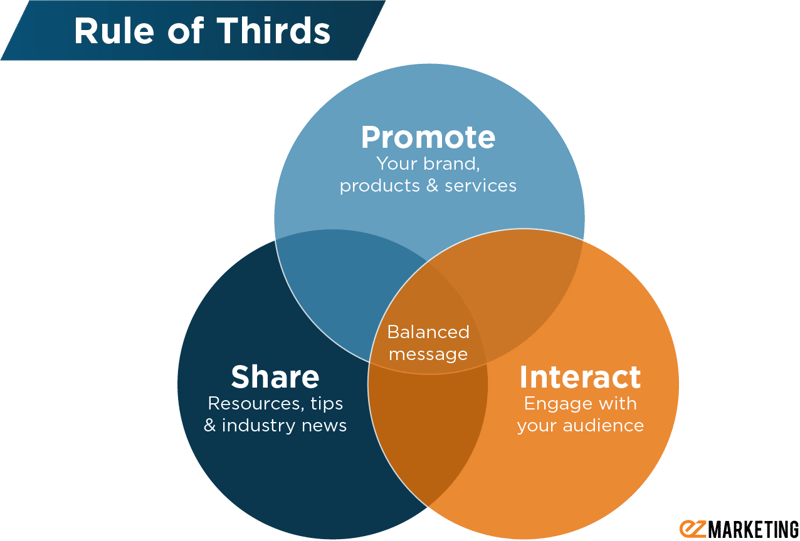
The Rule of Thirds is all about striking a balance between promoting your products and services, sharing ideas and news from other sources, and building personal interactions with your customers. Not only will this help you build your audience and keep them engaged, but it will keep your social content fresh and add variety to the types of content you post.
In the over-saturated world of social media, it’s important to stand out, and a balanced social media strategy will allow you to build an audience and keep them engaged.
Be Relevant
It’s not enough to just be “on” social media and post for the sake of posting. Finding your voice and figuring out what your audience is interested in is also key.
Relevance is the overlap between what you want to say and what your audience wants to talk about. Focus on keywords that your audience is searching for and use social listening to learn about your audience’s needs and wants.
Also, remember that social media algorithms are more interested in how much people engage with your content, not how much you publish. It’s better to have less content with higher quality than to have more content with a lower quality.
Be Consistent
Do you sometimes see pages that post five times a day for three days straight, and then go silent for a week? We’ve seen it too, and we’re here to tell you that it’s not good practice.
Posting consistently not only improves engagement, but it also keeps your audience happier. If your customers know you post new products every Friday at noon, they’re more likely to return to your page to get the content they’re looking for. You can use the analytics tools within your social platforms to see what days of the week and times of day work best for your business, so you can space out your posts appropriately.
Be Visual
We’ve already mentioned how important having visual social media content is for your business, but it’s worth mentioning again.
Why? Visual content drives engagement. In fact, Facebook posts with images get 2.3 times more engagement than those without.
Visual content is also more memorable, which is really important if you want people to remember your brand and your products. Studies have shown that after three days, people recall 65 percent of visual content versus only 10 percent of written content. I don’t know about you, but I’d like more than 10 percent of the people I talk with to remember me.
One caveat: make sure your visuals are high quality. No one wants to see a blurry picture of your office lunchroom—they’d rather see a high-quality image of the entire office. If you don’t have someone in-house to help you create visual assets, consider hiring a professional so you can get the best quality visuals possible. For DIYers, you can also use tools like Canva to create social media content specifically catered to different platforms.
Be Human
People love brands who are authentic, personable, and make them feel something. If you’re robotically pumping out the same uninspired content over and over, people are going to notice. And not in a good way.
This goes back to the concept of “don’t post for the sake of posting.” People will remember how you made them feel, so show them that there are real people behind your business. Don’t be afraid to have fun with it too!
Have a Calendar
A social media calendar is a great tool for helping you stay organized with posting. Not only does it allow you to keep track of posts months in advance, but it can also help you find a focus for each month or plan your content to support other marketing campaigns.
Have an Established Customer Response Plan
More and more people are turning to social media as their preferred channel for customer service and support. Whether you’re responding to positive or negative feedback, having an established response plan is critical to avoid any problems.
Thanking customers for compliments lets them know that you appreciate them, and responding quickly and sensitively to problems and complaints can help you avoid major marketing fails. Remember, time is of the essence, and you should always reply within 24 hours (at most) of receiving the message.
A Brand Doing Social Media Right
Here’s an example of one of our local Lancaster clients—Tangles Salon—following best practices with their social media marketing. Let’s look at a few of the things they’ve nailed with their content:
- It’s visual AND relevant: Their posts feature stunning, high-quality images that draw your attention to one major thing that both they and their customers care about—hair!
- It’s consistent: They have a regular posting schedule, and their visuals have a consistent style
- It’s human: Hair salons revolve around relationships, and they do a great job of giving shout-outs to their stylists, thanking their customers, and encouraging interaction.
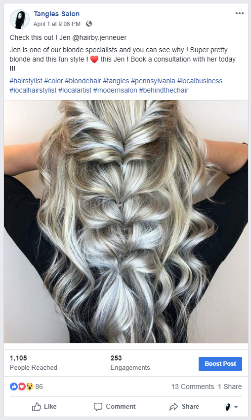
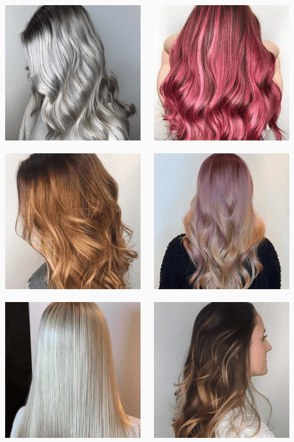

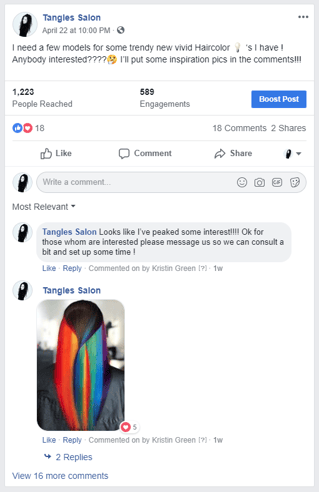
How Do You Optimize Your Social Media Content?
Awesome social media content does much more than just engage people. It’s also a great way to improve your Search Engine Optimization efforts and boost your overall online presence. While many of the same basic principles apply, each platform is a little different in how you should optimize and make the most of your content.
Let’s look at each of the major platforms one at a time.
Facebook Best Practices
Facebook is the largest social media platform on the market today—if you don’t have a Facebook page for your business, you’re already doing yourself a disservice. Here are a few things you can do to make sure your Facebook Business Page is well-optimized and has good SEO practices in place:
- Keep Your About Page Up to Date: Any new visitor on your page is likely to stop here to learn what your business is all about. Make sure you have all of the information filled out, especially contact information.
- Sprinkle in Keywords: If you want to rank better in searches, using your keywords throughout posts and content naturally will help to improve your business’s rankings.
- Encourage Engagement: Facebook rewards posts for being engaging—the more engagement a post has, the more likely it’ll be to show up on other people’s timelines and increase brand awareness.
YouTube Best Practices
After Google, YouTube is the second most-used search engine on the internet. If your marketing plan includes video content (which it should), make sure you follow a few of these social media best practices to make sure your content shows up in searches:
- Keywords, Keywords, Keywords: In your title, tags, description, and anywhere else you can fit them, make sure your video uses high-value, relevant keywords.
- Closed Captioning: Do you ever try to watch a video in public, but skip right over it if it doesn’t have subtitles or captioning? Don’t be one of those videos. Add closed captioning to your video content to make it more accessible for viewers and give Google even more keywords to pull from.
- Use Add Cards and End Screens: Tell viewers what you want them to do next. Cards and end screens give them opportunities to click through to see more of your content, visit your website, or check out other channels you support.
Instagram Best Practices
As a highly visual platform, Instagram can sometimes be difficult for search engines. Instagram actually blocks user images from appearing in search results, but there are a few things you can do to make sure you have your best SEO marketing foot forward for Instagram:
- Link Directly to Posts: Make sure you share direct links to your Instagram posts in your blog or on your website. This will help your posts get indexed and appear higher in search results.
- Use Appropriate Hashtags: Instagram is the king of hashtags—if you want your content to be found, make sure you’re tagging each of your posts appropriately. Also, make sure the tags are relevant to your target audience.
- Use Keywords in Your Bio or Username: Don’t go overboard and stuff your profile or name with keywords, but be smart about it. If your pizza restaurant is called “Bob’s,” don’t use that alone as your username—make it “Bob’s Pizza” or something similar.
Twitter Best Practices
Twitter is a great social media platform for sharing content in a timely manner. It’s very fast paced, but if optimized correctly, your social media content can get a nice boost from trending topics:
- More Keywords and Hashtags: If you haven’t noticed this trend yet, keywords are your best friend for search engine optimization. Twitter has a big focus on hashtags, so adding more into your posts will improve your results—just make sure you can do it in less than 280 characters.
- Promote Your Content for Link Building: This may seem obvious, but sharing links and blog content on your profile are great for building backlinks to your site. Don’t fall into the trap of automated posting and coming off as spam though. Instead, we recommend posting manually.
- Retweet Relevant Content: Want people to like and retweet your content? Do the same thing on your own profile. Retweeting, connecting, and sharing other content is what Twitter is all about, so don’t be shy about interacting on Twitter!
LinkedIn Best Practices
LinkedIn is a great space for professionals and businesses to connect and share content. It’s not just for people seeking jobs! You can utilize your business’s LinkedIn page to help connect with other businesses and potential clients. Here are a few ways to improve your rankings:
- Complete Your Profile: LinkedIn will send you notifications about completing your profile, so don’t ignore them forever! Filling out your profile not only helps add in more keywords, but it optimizes your page for searches on LinkedIn.
- Update Frequently: Not all of the visual posts you share on other social media platforms will be relevant to LinkedIn, but informative or educational content is well received. Keep other businesses and your followers in the loop by adding fresh content to your page from time to time, and ask your employees to share updates.
- Network and Interact: As we already mentioned, LinkedIn is a great place to network with other professionals. Don’t hold back when it comes to adding connections or commenting on updates, because LinkedIn will prioritize those connections for yourself and for others.
Pinterest Best Practices
Pinterest is another visual-heavy social media platform. It may not be necessary or relevant for every business, but it can be a powerhouse for promoting content and products when used correctly:
- Keep Images Vertical: While you can pin any size image on Pinterest, vertical images take up the most visual space in consumer’s feeds. Taking up more space means it’s more likely that your social media content will get noticed.
- Do Keyword Research: By now, you should understand the importance of using keywords in any type of social media marketing strategy. Pinterest is no different in this regard, so take the time to see how Pinterest pairs keywords together for specific searches.
- Keep Boards Organized: Think like your customers—if your boards are messy and hard to navigate through, people aren’t going to stay on your Pinterest page. Using a mix of good titles (with keywords) and quality images will help improve your SEO marketing.
Need to keep your content and posting schedule organized? Download our free social media content calendar template. Our Lancaster digital agency can help plan and manage your social media marketing. Just give us call.

